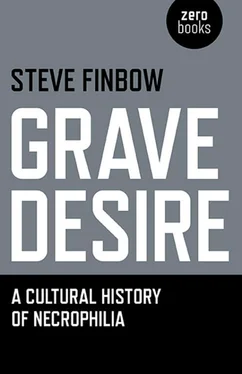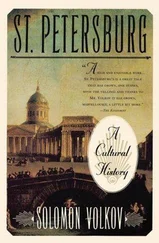These edifices, these architectures of forbidden yet realized desire, these tomb/wombs for an object already and always gone, are structures of anti-repression, fortresses of desire as a ‘countereffect of lack.’ If desire is the ‘abject fear of lacking something,’ [84] Anti-Oedipus, p. 27.
then the maintenance of the body, even if it is an inanimate vessel for sexual congress, is also an attempt to preserve and sustain the real, for ‘if desire produces, its product is real. If desire is productive, it can be productive only in the real world and can produce only reality. Desire is the set of passive syntheses that engineer partial objects, flows, and bodies, and that function as units of production. The real is the end product, the result of the passive syntheses of desire as the autoproduction of the unconscious.’ [85] Anti-Oedipus, p. 26.
The dead agents of desire were as real to the Moche, to Achilles, to Herod, to Dimoetes, to von Cosel as their priests, warriors, slaves, and fellow workers, they were products of the necrophile’s reality, produced out of the flow of saliva over their dead bodies, the end product of semen within, the passive bodies synthesizing with the active functions of the partial objects—mouth, penis, testicles—of the living lovers, the architects of their sumptuous sarcophagi, their thanatic stone boudoir.
The Metaphysical poet Henry Vaughan (1622-1695) wrote:
Dear, beauteous Death! the jewel of the Just,
Shining nowhere, but in the dark;
What mysteries do lie beyond thy dust,
Could man outlook that mark! [86] Metaphysical Poetry, ed. Colin Burrow (London, 2006), p. 226.
His twin brother Thomas hints that he may have breached that mark, transgressing morality and religious teachings in the pursuit of magic. Thomas Vaughan, alchemist Kabbalist, Rosicrucian, and occultist explains in his essay ‘Aqua vitae non vitis’, ‘On the same day my dear wife sickened, being a Friday, and at the same time of the day, namely in the evening, my gracious God did put into my heart the secret of extracting the oil of Halcali, which I had once accidentally found at the Pinner of Wakefield in the days of my most dear wife. But it was again taken from me by a most wonderful judgement of God, for I could never remember how I did it, but made a hundred attempts in vain. And now my glorious God (Whose name be praised for ever) has brought it again into my mind, and on the same day my dear wife sickened; and on the Saturday following, which was the day she died on, I extracted it by the former practice: so that on the same day, which proved the most sorrowful to me, whatever can be, God was pleased to confer upon me the greatest joy I can ever have in this world after her death.’ [87] Thomas Vaughan, The Works of Thomas Vaughan, ed. Arthur Edward Waite (Whitefish MT, 2010), p. 446.
The editor notes that the ‘former practice’ involved the ‘dark fashion’ of ‘viscous and spermatic humidity’ [88] The Works of Thomas Vaughan, p. xii.
in order to extract the ‘menstruum universale’. The Metaphysical poets equated love with death, sex with decay, inspiration with expiration. George Herbert’s ‘Mortification’: ‘That dumbe inclosure maketh love / Unto the coffin, that attends his death,’ and in ‘Death’ Herbert believes death’s ‘bones with beauty shall be clad.’ Donne, militantly positive, states in ‘Death, be not proud’ that from death ‘Much pleasure; then from thee much more must flow, / And soonest our best men with thee do go,’ in these poems there is an almost erotic sense of the presence of death, Marvell even invokes the terror of vermicular necrophiliac rape in an attempt to seduce his mistress.
But at my back I always hear Time’s winged chariot hurrying near:
And yonder all before us lie
Deserts of vast eternity.
Thy beauty shall no more be found;
Nor, in thy marble vaults, shall sound
My echoing song; then worms shall try
That long-preserved virginity,
And your quaint honour turn to dust,
And into ashes all my lust:
The grave’s a fine and private place,
But none, I think, do there embrace. [89] Metaphysical Poetry, p. 198.
The American poet Kenneth Rexroth argued that Thomas Vaughan’s mystical writings under the name ‘Eugenius Philalethes’ were exegeses on sexual methodology, particularly Tantric sex, in which the sexual fluids of the yogi and yogini cover the body of the initiate.
When the playwright William Congreve—author of The Mourning Bride—died in 1729, his mistress Henrietta Godolphin, 2 ndDuchess of Marlborough, had a realistic mannequin made, dressed it in Congreve’s clothes, fitted his death mask to it and slept with it, finally taking it to her grave in 1733. In the early eighteenth century, Sir John Price had his first wife’s body embalmed and placed in his bed. He, his corpse, and his second wife slept together. When his second wife died and he, too, had her embalmed and placed next to his first corpse bride, his third wife politely asked if he would not mind burying the bodies, after all, there could not have been much room.
The Marquis de Sade’s Justine, published in 1791, depicts various acts of necrophilia. After being split nearly in half by the engorged penis of a sexually-enraged donkey, a young woman, her intestines spilling out onto the floor, dies and her wound is penetrated by an onlooker while another licks the donkey’s excrement-stained anus. [90] Marquis de Sade, The Complete Marquis de Sade, Vol. 1., trans. Dr Paul J. Gillette (Los Angeles, 2005), p. 134.
In Juliette (1797-1801), a father rapes his daughter’s disinterred corpse and Juliette asks four men to sodomize her dead sister. In The 120 days of Sodom (1785), a man hires prostitutes and visits funeral parlours, standing over the coffins, he has the women masturbate him so that his semen splashes onto the dead bodies. [91] The Complete Marquis de Sade, p. 226.
Another man sodomizes the body of a dead boy while kissing the buttocks of a dead girl. Yet another kills a woman while buggering her and then has vaginal sex with the body. A father copulates with his daughter while pretending she is dead. Corpses—fresh or putrid—are subjected to vaginal, anal, and oral sex, wounds are penetrated, and they are given enemas and raped with dildos. Foucault writes, ‘In Sade, sex is without any norm or intrinsic rule that might be formulated from its own nature, but it is subject to the unrestricted law of a power which itself knows no other law but its own; if by chance it is at times forced to accept the order of progressions carefully disciplined into successive days, this exercise carries it to a point where it is no longer anything but a unique and naked sovereignty: an unlimited right of all-powerful monstrosity.’ [92] Michel Foucault, The History of Sexuality, p. 149.
As Blanchot would have it, Sade resides in the ‘anonymous tomb of his renown,’ [93] Maurice Blanchot, The Writing of the Disaster, trans. Ann Smock (Lincoln, 2005), p. 45.
his books are edifices of desire and death, his removed skull as psycho-scientifically studied as that of the poisoned skull of Gloriana in Middleton / Tourneur’s necrophiliac The Revenger’s Tragedy. Sade created the space of transgression, the architecture of a will to desire where human bones are used as dildos disregarding and destroying any laws of nature, any divine interference, and royal proclamation, he opened the ‘uncanny abyss of freedom without any ontological guarantee in the Order of Being.’ [94] Slavoj Žižek, The Parallax View, (Cambridge MA, 2009), p. 93.
In Sade’s works necrophiliac ‘eroticism seems to derive from the transgressive and fetishistic nature of the act rather than from a specific focus on the dead body as a sexually arousing object… necrophilia is a graphic expression of the libertine’s megalomania, in that the dead body’s utter defencelessness allows him to enact the fantasy of total domination.’ [95] John Phillips, Sade: The Libertine Novels (London, 2001), p. 140.
Читать дальше












